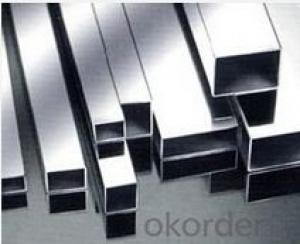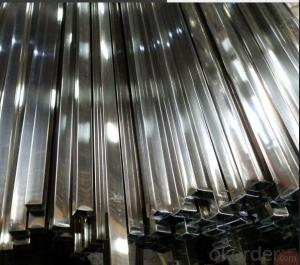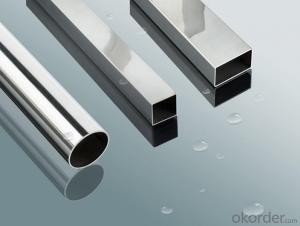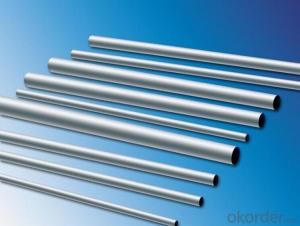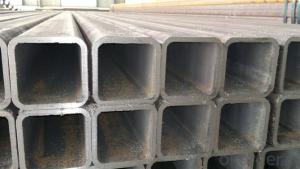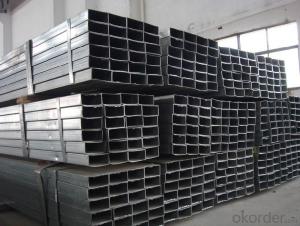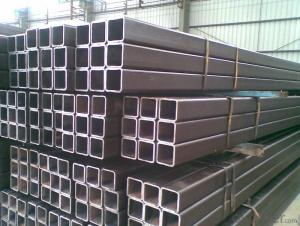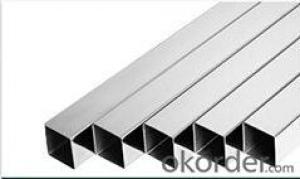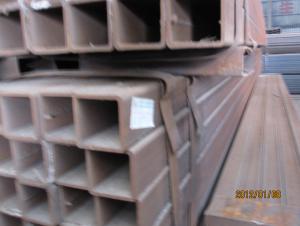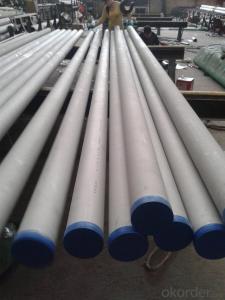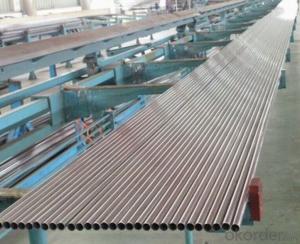Stainless seamless square steel pipe
- Loading Port:
- China Main Port
- Payment Terms:
- TT OR LC
- Min Order Qty:
- -
- Supply Capability:
- -
OKorder Service Pledge
OKorder Financial Service
You Might Also Like
Square Stainless seamless Steel Pipe
Product | Stainless Steel Square Pipe/ Stainless Steel Seamless Pipe | |
Standard | ASTM A213,ASTM A312, ASTM A269,ASTM A789, JIS G3456 JIS G3459, JIS G3463, JIS G3448 EN 10216 | |
Material | 200 Series | 300 Series |
201,202 | 301,304,304L,309S,310S,316,316L,317L,321,347 | |
Thickness | 0.2mm-80mm | |
Width | 10*10mm-300*300mm | |
Length | 1m,3m,5.8m,6m or as demand | |
Treatment | Hot Rolled,Cold Drawn | |
Application | Stainless Steel Square Pipe is widely used in Building Constructure,Machine Equipment, Water Piping,Decoration industry,Electrical and Chemical Industry | |
- Q: Can stainless steel pipes be used for exhaust systems?
- Yes, stainless steel pipes can be used for exhaust systems. Stainless steel is a popular material for exhaust systems due to its high resistance to corrosion and heat. It can withstand the extreme temperatures and harsh conditions that exhaust systems are subjected to, making it a durable and long-lasting option. Stainless steel pipes also have the advantage of being lightweight, which can help improve the performance of the exhaust system. Additionally, stainless steel pipes can be easily bent and shaped, allowing for customization to fit different vehicle models and configurations. Overall, stainless steel pipes are a reliable choice for exhaust systems, providing excellent performance and longevity.
- Q: What is the difference between annealed and pickled stainless steel pipes?
- Annealed stainless steel pipes are heat-treated to remove internal stresses, making them softer and more malleable. This process improves their machinability and allows for easier forming and welding. On the other hand, pickled stainless steel pipes undergo a chemical treatment (usually with an acid solution) to remove surface impurities and oxide layers. This process enhances the corrosion resistance of the pipes and provides a smooth, clean surface finish.
- Q: Can stainless steel pipes be hydrotested?
- Yes, stainless steel pipes can be hydrotested. Hydrostatic testing is a common method used to check the integrity and strength of pipes. It involves filling the pipes with water or another suitable liquid and applying pressure to the pipes to check for leaks or failures. Stainless steel pipes are often used in various industries due to their corrosion resistance and durability. Therefore, they can undergo hydrotesting to ensure their reliability and performance. However, it is important to follow the appropriate safety guidelines and procedures while conducting hydrotesting on stainless steel pipes to prevent any potential damage or accidents.
- Q: Can stainless steel pipes be insulated with polyacrylonitrile?
- Yes, stainless steel pipes can be insulated with polyacrylonitrile (PAN). Polyacrylonitrile is a versatile and commonly used polymer that possesses excellent thermal insulation properties. It is often used as a foam or fiber insulation material due to its low thermal conductivity and high resistance to heat transfer. Polyacrylonitrile insulation can be easily applied to the surface of stainless steel pipes to reduce heat loss or gain, improve energy efficiency, and prevent condensation. It also provides protection against corrosion and mechanical damage.
- Q: How do you prevent rusting in stainless steel pipes?
- There are several measures that can be taken to prevent rusting in stainless steel pipes: 1. Keeping the pipes clean regularly is important. Use mild soap or detergent and warm water to remove dirt, debris, and contaminants that can cause corrosion. 2. Avoid using abrasive cleaners, steel wool, or harsh chemicals as they can scratch the surface of the stainless steel and compromise its protective layer. 3. Protect the pipes from exposure to chlorides, such as those found in saltwater or certain cleaning agents. If the pipes are installed in areas with these substances, apply protective coatings or use specialized stainless steel grades that are resistant to chloride-induced corrosion. 4. Proper ventilation is crucial to prevent moisture buildup, which can accelerate the rusting process. Ensure that the stainless steel pipes have adequate airflow to keep them dry and reduce the risk of corrosion. 5. Regularly inspect the pipes for signs of rust or corrosion. If any damage or rust spots are detected, address them promptly to prevent further deterioration. 6. Consider passivation, a chemical treatment process that enhances the corrosion resistance of stainless steel. This involves removing contaminants from the surface and promoting the formation of a protective oxide layer. It is recommended to have professionals with experience in handling stainless steel perform the passivation process. 7. In certain cases, cathodic protection can be used. This involves using sacrificial anodes or impressed current systems to create an electrochemical reaction that protects the stainless steel from corrosion. By following these preventive measures, the risk of rusting in stainless steel pipes can be significantly reduced, ensuring their longevity and durability.
- Q: Can stainless steel pipes be used for underground irrigation systems?
- Yes, stainless steel pipes can be used for underground irrigation systems. Stainless steel is a durable and corrosion-resistant material, making it suitable for applications where the pipes will be exposed to moisture and soil conditions. It is also a popular choice for underground irrigation systems because it can withstand high pressure and temperature fluctuations. Additionally, stainless steel pipes have a longer lifespan compared to other materials, reducing the need for frequent replacements or repairs. However, it is important to ensure that the pipes are properly installed and insulated to prevent any potential damage from soil movement or other external factors.
- Q: Stainless steel pipe 301 material and 304 material what is the difference?
- 304 is a versatile stainless steel which is widely used in the manufacture of equipment and parts requiring good overall performance (corrosion resistance and formability)
- Q: Are stainless steel pipes suitable for wastewater pumping stations?
- Stainless steel pipes prove to be a suitable option for wastewater pumping stations. Their exceptional corrosion resistance makes them ideal for environments abundant in moisture and chemicals, like wastewater pumping stations. These pipes are impervious to rust and can withstand the corrosive properties of wastewater, which often contains a variety of chemicals and contaminants. Furthermore, stainless steel pipes possess remarkable strength and durability, allowing them to handle the pressure and flow demands of wastewater pumping systems. Additionally, they have a smooth interior surface that minimizes friction, thereby enhancing water flow efficiency. In conclusion, stainless steel pipes are an outstanding selection for wastewater pumping stations, thanks to their corrosion resistance, strength, and durability.
- Q: What is the difference between 446 and 316 stainless steel pipes?
- The chemical composition and intended use distinguish 446 stainless steel pipes from 316 stainless steel pipes. 446 stainless steel, a heat-resistant alloy, is ferritic and contains chromium, molybdenum, and small amounts of silicon and carbon. This composition grants 446 stainless steel exceptional oxidation resistance at high temperatures, making it suitable for the automotive, power generation, and thermal processing industries. It can withstand temperatures up to 1500°C (2730°F) and displays good corrosion resistance in specific environments. Conversely, 316 stainless steel is an austenitic, corrosion-resistant alloy containing chromium, nickel, and molybdenum. Due to its superior corrosion resistance and ability to endure harsh conditions, it finds wide application in industries such as food processing, pharmaceuticals, marine applications, and chemical processing. Additionally, 316 stainless steel offers good resistance to pitting and crevice corrosion, making it appropriate for chloride-containing environments. In terms of mechanical properties, 446 stainless steel generally exhibits lower tensile strength and hardness compared to 316 stainless steel. However, it compensates for this by providing better high-temperature oxidation resistance. Conversely, 316 stainless steel possesses higher tensile strength and hardness, resulting in superior overall mechanical properties. In conclusion, while both 446 and 316 stainless steel pipes offer corrosion resistance, their chemical composition and specific application areas are the key distinguishing factors. 446 stainless steel is primarily suitable for high-temperature environments, whereas 316 stainless steel is more versatile and extensively employed in various industries due to its superior corrosion resistance properties.
- Q: Can stainless steel pipes be used for sewage disposal?
- Yes, stainless steel pipes can be used for sewage disposal. Stainless steel is a highly durable and corrosion-resistant material, making it suitable for handling sewage and wastewater. It is resistant to various chemicals and acids commonly found in sewage, ensuring the pipes' longevity and minimizing the risk of leaks or breaks. Additionally, stainless steel pipes have smooth inner surfaces, which helps prevent the buildup of waste and inhibits the growth of bacteria or other harmful substances. Overall, stainless steel pipes are a reliable and appropriate choice for sewage disposal systems.
Send your message to us
Stainless seamless square steel pipe
- Loading Port:
- China Main Port
- Payment Terms:
- TT OR LC
- Min Order Qty:
- -
- Supply Capability:
- -
OKorder Service Pledge
OKorder Financial Service
Similar products
Hot products
Hot Searches
Related keywords
